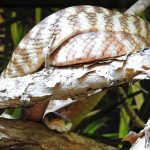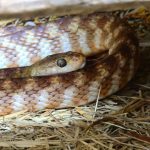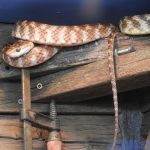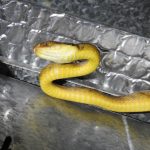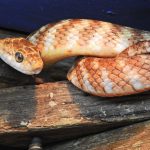BROWN TREE SNAKE
Brown Tree Snake
The Brown Tree Snake is a slender, nocturnal snake native primarily to Australia, Papua New Guinea, and parts of Indonesia. With its striking appearance and fascinating habits, this species offers a captivating window into the delicate balance of Australia’s natural environments.
Appearance
Brown Tree Snakes are distinguished by their slim, elongated bodies and large, expressive eyes that allow for exceptional night vision. Their patterned skin features bands of brown, olive, or reddish hues set against a lighter background, providing flawless camouflage among tree branches and forest floor debris. Adults typically measure between 1 and 2 metres, although some individuals may exceed this length.
Behaviour and Diet
Being nocturnal, the Brown Tree Snake conceals itself in tree hollows or crevices during the day. At night, it moves quietly through the trees and over the ground, seeking prey. This opportunistic feeder hunts a variety of animals, including birds, small mammals, and reptiles. Equipped with mildly venomous rear fangs, it uses its venom primarily to immobilise prey, rarely posing any substantial risk to humans.
Breeding and Reproduction
The breeding season for Brown Tree Snakes usually coincides with the warmer months. Females lay a clutch of 4 to 12 leathery eggs, often in a hidden and sheltered location such as under bark, within tree hollows, or in rock crevices. Unlike some reptiles, the female does not guard the eggs. Instead, she relies on the environment’s warmth and humidity to provide suitable incubation, which generally lasts between two and three months. Upon hatching, the young snakes are fully independent, immediately embarking on their solitary lives and hunting for small prey. The process highlights both the resilience and vulnerability of this species during its early life stages.
Habitat and Distribution
In Australia, the Brown Tree Snake is most frequently found in northern and eastern coastal regions, especially Northern NSW, Queensland and the Northern Territory. It inhabits woodlands, forests, mangroves, and occasionally urban areas where food sources are plentiful.
Ecological Impact and Conservation
While native to Australia, the Brown Tree Snake gained notoriety after its accidental introduction to Guam, where a lack of natural predators led to a dramatic population increase. This has had severe consequences for native bird and small mammal populations in Guam, illustrating the challenges of managing invasive species.
Back in Australia, the Brown Tree Snake plays an important ecological role as a predator, helping maintain balanced populations of small animals. Although not considered endangered, their story emphasises the importance of protecting native ecosystems and preventing the spread of non-native species.
Conservation Message
Observing the life cycle of the Brown Tree Snake—from breeding and egg-laying through to the emergence of young—illustrates the interconnectedness and intricacy of Australia’s ecosystems. By learning about species like Boiga irregularis, we foster a deeper appreciation for our native wildlife and a commitment to safeguarding their habitats for the benefit of future generations.
Every encounter with a Brown Tree Snake, whether in the wild or through learning, deepens our connection to the natural world. Each stage in its life has a vital role in the ecosystem, reminding us of the importance of stewardship, understanding, and respect for our unique environment.

